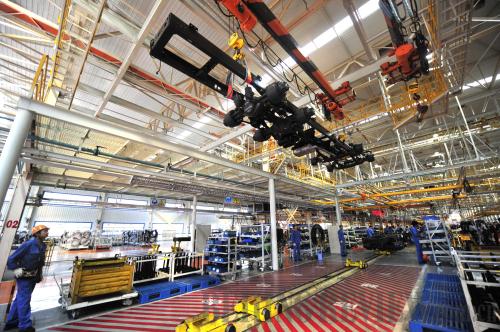|
 |
|
STRONG SOE: An auto frame hangs over the assembly line at Donfeng Motor Corp.'s heavy truck manufacturing base in Shiyan, central China's Hubei Province. Dongfeng is one of China's largest state-owned auto makers (HAO TONGQIAN) |
China's SOEs were established as part of the country's planned economy in the past, and their internal structure, management system, social positioning and employees' spirit were totally different from companies facing market competitions.
"It takes time to reform such a huge state-owned economic sector to meet the standard of the market economy," said Shao.
Five major problems bottlenecking the development of SOEs have been tackled after the two-decade reform.
First, fundamental changes have taken place in the layout structure of the state-owned economy. Second, the relationship between SOEs and the government has been changed; government and banks are no longer financially responsible for SOEs, forcing them to become independent subjects in market competition. At present, 52.88 percent of the total assets, 68.05 percent of the net assets and 59.65 percent of the revenues of central SOEs have been held by their listed companies. Third, a system that enables the competitive SOEs to prosper and eliminates inefficient SOEs has been established. Fourth, the state-owned assets supervision and administration system has been established at all levels. Fifth, market-oriented recruitment and employment as well as remuneration and incentives have been established preliminarily.
If not for marketization reform SOEs could not survive, not to mention develop, said Shao.
The key to SOE reform in the future will be integration of the SOEs with the market economy. Better forms of integration include public corporate reform based on the capital market, diversification of enterprises and capitalization of state-owned assets, said Shao.
Five strategies
"Focusing on the target—to become world-class multinationals—central SOEs need to carry out five main strategies, namely the strategy of transforming and upgrading, the strategy of sci-tech innovation, the strategy of internationalized operation, the strategy of strengthening enterprises through talented personnel, and the strategy of harmonious development," said Shao.
Implementing the strategy of transformation and upgrading means the development model for central SOEs will more rely on sci-tech progress, quality improvement of the labor force and management innovation. State capital should be further concentrated and put into key areas, industrial layout further upgraded to the high end of the industrial chain and emerging strategic industries, and ownership structure further transformed by means of joint-stock reform, shareholder diversification and securitization.
The strategy of sci-tech innovation requires that central SOEs will further increase investment in research and development (R&D) and establish the mechanisms of R&D investment, R&D, transformation and application of scientific and technological innovations. Central SOEs should also build R&D platforms to develop advanced technologies, make technological breakthroughs, develop a batch of cutting-edge products and create world famous brands.
| 